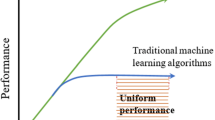Abstract
The formation of protein secondary structure especially the regions of β-sheets involves long-range interactions between amino acids. We propose a novel recurrent neural network architecture called segmented-memory recurrent neural network (SMRNN) and present experimental results showing that SMRNN outperforms conventional recurrent neural networks on long-term dependency problems. In order to capture long-term dependencies in protein sequences for secondary structure prediction, we develop a predictor based on bidirectional segmented-memory recurrent neural network (BSMRNN), which is a noncausal generalization of SMRNN. In comparison with the existing predictor based on bidirectional recurrent neural network (BRNN), the BSMRNN predictor can improve prediction performance especially the recognition accuracy of β-sheets.
Similar content being viewed by others
References
Bengio Y, Simard P, Frasconi P (1994) Learning long-term dependencies with gradient descent is difficult. IEEE Trans Neural Net 5(2):157–166
Casbon J (2002) Protein secondary structure prediction with support vector machines. Master's thesis, University of Sussex
Cuff J, Barton G (1999) Evaluation and improvement of multiple sequence methods for protein secondary structure prediction. Proteins 34:508–519
Cuff J, Barton G (2000) Application of multiple sequence alignment profiles to improve protein secondary structure prediction. Proteins 40:502–511
Elman J (1991) Distributed representations,simple recurrent networks, and grammatical structure. Machine Learn 7(2/3):195–226
Francesco V, Garnier J, Munson P (1996) Improving protein secondary structure prediction with aligned homologous seqeunces. Prot Sci 5:106–113
Frick R (1989) Explanations of grouping effects in immediate ordered recall. Cognition 17:551–562
Frishman D, Argos P (1995) Knowledge-based protein secondary structure assignment. Proteins 23(4):566–579
Gibrat J, Garnier J, Robson B (1987) Further developments of protein secondary structure prediction using information theory. J Mol Biol 198:425–443
Gromiha M, Selvaraj S (1998) Protein secondary structure prediction in different structural classes. Protein Eng 11:249–251
Hitch G, Burgess N, Towse J, Culpin V (1996) Temporal grouping effects in immediate recall: a working memory analysis. Quarterly J Exp Psychol 49A:116–139
Hua S, Sun Z (2001) A novel method of protein secondary structure prediction with high segment overlap measure: Support vector machine approach. J Mol Biol 308:397–407
Jones D (1999) Protein secondary structure prediction based on position-specific scoring matrices. J Mol Biol 292:195–202
Kabsch W, Sander C (1989) Dictionary of protein secondary structure: pattern recognition of hydrogen-bonded and geometrical features. Biopolymers 22:2577–2637
Kumarevel T, Gromiha M, Ponnuswamy M (2000) Structural class prediction: an application of residue distribution along the sequence. Biophys Chem 88:81–101
Levitt M, Chothia C (1976) Structural patterns in globular proteins. Nature 261:552–558
Luo R, Feng Z, Liu J (2002) Prediction of protein structural class by amino acid and polypeptide composition. Eur J Biochem 269:4219–4225
Matthews B (1975) Comparison of the predicted and observed secondary structure of t4 phage lysozyme. Biochim Biophys Acta 405:442–451
Moult J, Hubbard T, Bryant S, Fidelis K, Pedersen J (1997) Critical assessment of methods of protein structure prediction(casp): round ii. Proteins Struct Funct Genet 29:2–6
Orengo C, Bray J, Hubbard T, LoConte L, Sillitoe I (1999) Analysis and assessment of ab initio three-dimensional prediction, secondary structure, and contacts prediction. Proteins Struct Funct Genet 37:149–170
Pollastri G, Przybylski D, Rost B, Baldi P (2002) Improving the prediction of protein secondary structure in three and eight classes using recurrent neural networks and profiles. Proteins 47:228–235
Przybylski D, Rost B (2001) Alignments grow, secondary structure prediction improves. Proteins Struc Funct Genet 46:197–205
Richards F, Kundrot C (1988) Identification of structural motifs from protein coordinate data:secondary structure and first-level supersecondary structure. Proteins 3:71–84
Richardson J, Richardson D (1989) Principles and patterns of protein conformation. Plenum Press, New York, pp 1–98
Riis S, Krogh A (1996) Improving prediction of protein secondary structure using structural neural networks and multiple sequence alignment. J Comp Biol 3:163–183
Rost B (1996) Phd:predicting one-dimensional protein structure by profile based neural networks. Meth Enzymol 266:525–539
Rost B, Sander C (1993) Prediction of protein secondary structure at better than 70% accuracy. J Mol Biol 232:584–599
Rost B, Sander C (1994) Combining evolutionary information and neural networks to predict protein secondary structure. Proteins 19:55–72
Ryan J (1969a) Grouping and short- term memory: different means and patterns of grouping. Q J Exp Psychol 21:137–147
Ryan J (1969b) Temporal grouping, rehearsal and short-term memory. Q J Exp Psychol 21:148–155
Severin F, Rigby M (1963) Influence of digit grouping on memory for telephone numbers. J Appl Psychol 47:117–119
Wickelgren W (1967) Rehearsal grouping and hierarchical organization of serial position cues in short-term memory. Q J Exp Psychol 19:97–102
Yi T, Lander E (1993) Protein secondary structure prediction using nearest-neighbor methods. J Mol Biol 232:1117–1129
Zemla A, Venclovas C, Fidelis K, Rost B (1999) A modified definition of sov, a segment-based measure for protein secondary structure prediction assessment. Proteins Struct Funct Genet 34:220–223
Author information
Authors and Affiliations
Corresponding author
Rights and permissions
About this article
Cite this article
Chen, J., Chaudhari, N. Bidirectional segmented-memory recurrent neural network for protein secondary structure prediction. Soft Comput 10, 315–324 (2006). https://doi.org/10.1007/s00500-005-0489-5
Published:
Issue Date:
DOI: https://doi.org/10.1007/s00500-005-0489-5




